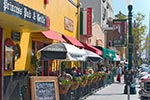 The
Little Italy street sign, erected in
1999, on India Street between Date and
Fir identifies the neighborhood that
serves as the heart and soul of San
Diego's Italian American community. The
Little Italy street sign, erected in
1999, on India Street between Date and
Fir identifies the neighborhood that
serves as the heart and soul of San
Diego's Italian American community.
More than a half-dozen annual festivals
are hosted in Little Italy each year
including celebrations of holidays,
music and art including Carnivale (Mardi
Gras), "Chalk La Strada," Columbus Day
Festa, ArtWalk, a Bocce Ball Tournament,
and Easter celebrations.
 India
Street is the heart of the neighborhood
with outdoor cafes, restaurants,
galleries and specialty shops. Amici
Park provides a playground for
Washington Elementary School and a
community park complete with bocce ball
court. India
Street is the heart of the neighborhood
with outdoor cafes, restaurants,
galleries and specialty shops. Amici
Park provides a playground for
Washington Elementary School and a
community park complete with bocce ball
court.
Larger than the Little Italy
neighborhoods in San Francisco, St.
Louis or New York — this San Diego
historic waterfront district is making a
comeback after years of setbacks.
Little
Italy San Diego History
 Italians,
primarily from Genoa, Italy and Sicily
were drawn to California by the climate
and the geographical similarity to their
homeland. Italians,
primarily from Genoa, Italy and Sicily
were drawn to California by the climate
and the geographical similarity to their
homeland.
Those who came to San Diego tended to
form homogeneous communities like other
immigrants did in many cities throughout
the U.S. Quite a few of the earliest
arrivals adopted the area around Kettner
Boulevard, India, Columbia and State
Streets as their new home.
 Many
of the new arrivals had previously made
their livelihood from fishing in Italy
and it was natural for this industry to
become their focus in their new country. Many
of the new arrivals had previously made
their livelihood from fishing in Italy
and it was natural for this industry to
become their focus in their new country.
A
natural harbor and year round
Mediterranean climate eventually
resulted in San Diego becoming the home
base for the pacific coast tuna fishing
fleet.
 Italian
immigrants who didn't own or work on
fishing boats often started seafood
processing plants, seafood marketing
businesses or Italian restaurants
specializing in seafood. More than
40,000 people were employed directly or
indirectly by the tuna industry in San
Diego by the late seventies. Italian
immigrants who didn't own or work on
fishing boats often started seafood
processing plants, seafood marketing
businesses or Italian restaurants
specializing in seafood. More than
40,000 people were employed directly or
indirectly by the tuna industry in San
Diego by the late seventies.
The nearby Maritime Museum San Diego is
a place to learn more about San Diego's
seafaring experience.
 Several
events in U.S. and San Diego history had
negative impacts on Italian fishermen
including the U.S. involvement in WWII
and then later, in the early 1950's,
stiff competition from a revitalized
Japanese fishing fleet and foreign
control of bait resources and costal
waters south of the U.S. Several
events in U.S. and San Diego history had
negative impacts on Italian fishermen
including the U.S. involvement in WWII
and then later, in the early 1950's,
stiff competition from a revitalized
Japanese fishing fleet and foreign
control of bait resources and costal
waters south of the U.S.
 During
WWII the tuna boats range was
restricted, larger boats were
requisitioned by the Navy and Italian
residents legal status changed when ever
they left the territorial limits of the
U.S. — including while on a fishing
boat. By 1959 the tuna clipper fleet
shrank from 210 to 149 vessels. During
WWII the tuna boats range was
restricted, larger boats were
requisitioned by the Navy and Italian
residents legal status changed when ever
they left the territorial limits of the
U.S. — including while on a fishing
boat. By 1959 the tuna clipper fleet
shrank from 210 to 149 vessels.
In addition to the decline in the tuna
industry San Diego's Little Italy
neighborhood was literally cut in two by
construction of Interstate 5 displacing
many families to other parts of the
city. Fortunately for San Diego many of
the displaced families maintain
businesses in Little Italy and return
there to shop and worship.
 Our
Lady of the Rosary Church, an
Italian National Parish at 1659 Columbia
Street, was consecrated on November 15,
1925. The Parish Hall next to the Church
was inaugurated in 1939. Our
Lady of the Rosary Church, an
Italian National Parish at 1659 Columbia
Street, was consecrated on November 15,
1925. The Parish Hall next to the Church
was inaugurated in 1939.
Fausto Tasca decorated the ceiling and
the walls of Our Lady of the Rosary
Church with paintings depicting the
mysteries of the Rosary, the twelve
Apostles, a huge Crucifixion, and the
Last Judgment. There are also statues of
Our Lady, St. Anne, and St. Joseph by
the famous Californian Sculptor
Carlos Romanelli and several beautiful stained
glass windows in the church.
 The
Italian Cultural Center promotes,
celebrates and provides education about
Italian American culture. The
Italian Cultural Center promotes,
celebrates and provides education about
Italian American culture.
The
Pioneer Hook & Ladder Firehouse
Museum at 1572 Columbia Street in Little
Italy displays 150 years of firefighting
history from around the world. Housed in
the historic 1906 San Diego Fire Station
6 building firefighting equipment ,
photographs and memorabilia give
visitors a look into the past.
|